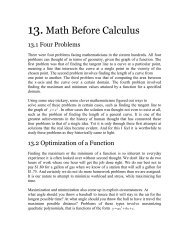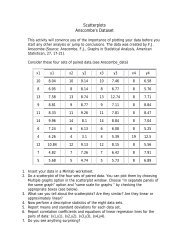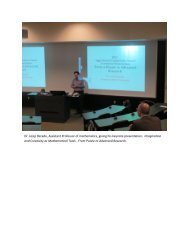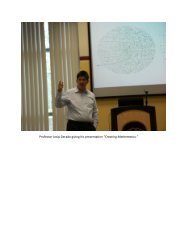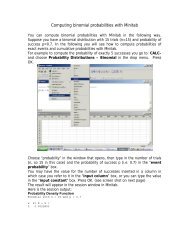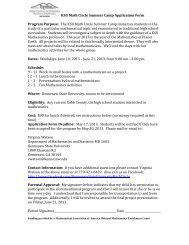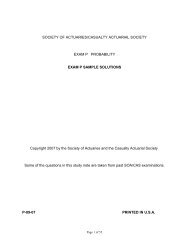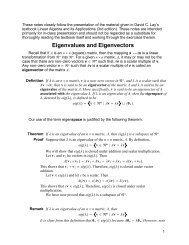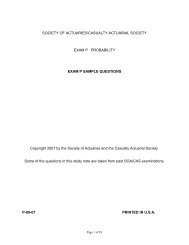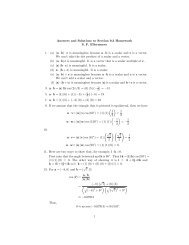P_PracticeExam6_05-1..
P_PracticeExam6_05-1..
P_PracticeExam6_05-1..
You also want an ePaper? Increase the reach of your titles
YUMPU automatically turns print PDFs into web optimized ePapers that Google loves.
The survival function for the Weibull distribution is sX ( x)<br />
= e<br />
)<br />
# x &<br />
!<br />
$<br />
%<br />
" '<br />
(<br />
PRACTICE EXAMINATION NO. 6<br />
for x > 0, and from the<br />
information given in the problem we have sX ( 3)<br />
= e !1 and sX ( 6)<br />
= e !4 . Therefore, e<br />
as well as e<br />
" 3 %<br />
#<br />
$<br />
! &<br />
'<br />
(<br />
that sX 4<br />
Answer D.<br />
)<br />
# 6 &<br />
!<br />
$<br />
%<br />
" '<br />
(<br />
= e !4 . We are looking for sX ( 4)<br />
= e<br />
= 1, or ! = 3. Furthermore, e<br />
( ) = e<br />
)<br />
# 4 &<br />
!<br />
$<br />
%<br />
" '<br />
(<br />
= e<br />
2<br />
# 4 &<br />
!<br />
$<br />
%<br />
3'<br />
(<br />
)<br />
# 6 &<br />
!<br />
$<br />
%<br />
" '<br />
(<br />
= e !2)<br />
= e !16<br />
9 * 0.1690133.<br />
)<br />
# 4 &<br />
!<br />
$<br />
%<br />
" '<br />
(<br />
. But e<br />
18. You are given that the hazard rate for a random variable X is<br />
! X ( x)<br />
= 1<br />
x" 1<br />
2<br />
2<br />
for x > 0, and zero otherwise. Find the mean of X.<br />
A. 1 B. 2 C. 2.5 D. 3 E. 3.5<br />
Solution.<br />
The hard way is to calculate the survival function of X via:<br />
! 1<br />
x 1<br />
!<br />
t 2 dt<br />
e<br />
" 2<br />
0<br />
! (<br />
= e<br />
x<br />
t ) 0<br />
for x > 0. Therefore,<br />
( ) = e ! x +"<br />
# dx<br />
0 ! # " $#<br />
Substitution of<br />
z= x ,2zdz=dx<br />
E X<br />
= e<br />
( ! x + 0 ) ! x<br />
= e<br />
+"<br />
+"<br />
! z<br />
= # 2ze dx = 2<br />
! z<br />
# ze dx = 2.<br />
0<br />
0 ! # " $#<br />
Mean of EXP(1)<br />
The easy way is to notice that this is the hazard rate<br />
! X ( x)<br />
= "<br />
# $ x<br />
" +1<br />
% (<br />
&<br />
'<br />
# )<br />
* = "<br />
# " $ x" +1<br />
for the Weibull distribution with ! = 1<br />
and ! = 1, so that<br />
2<br />
E( X)<br />
= !" 1+ 1 $ '<br />
%<br />
&<br />
# (<br />
) = 1* " 3 ( ) = 2! = 2.<br />
Answer B.<br />
)<br />
# 3 &<br />
!<br />
$<br />
%<br />
" '<br />
(<br />
)<br />
# 3 &<br />
!<br />
$<br />
%<br />
" '<br />
(<br />
= e !1 implies that<br />
= e !1 ,<br />
= e !4 implies that ! = 2. Therefore, we conclude<br />
ASM Study Manual for Course P/1 Actuarial Examination. © Copyright 2004-2007 by Krzysztof Ostaszewski - 275 -



